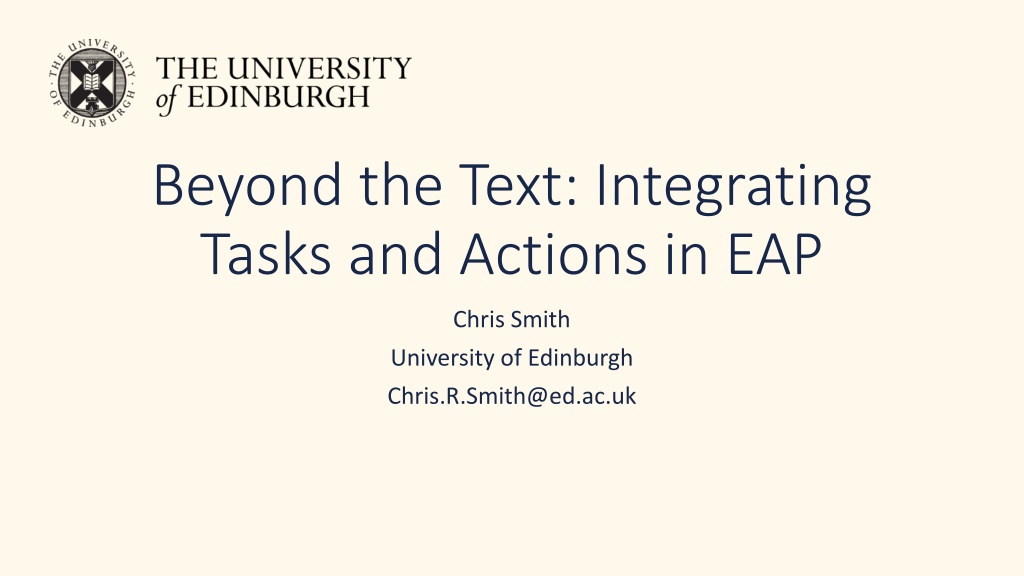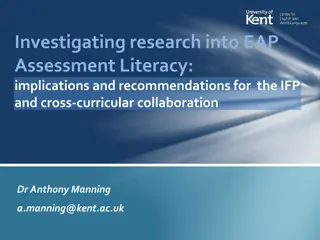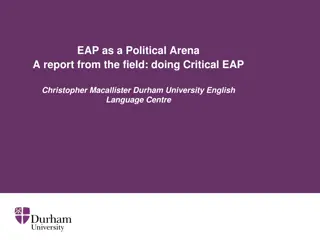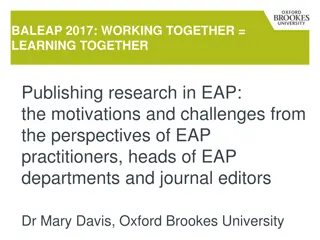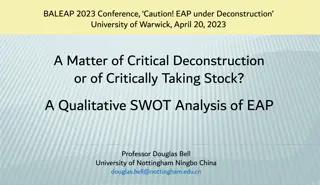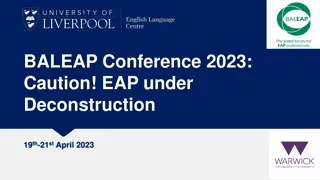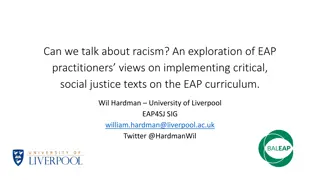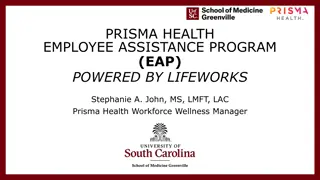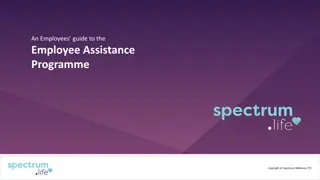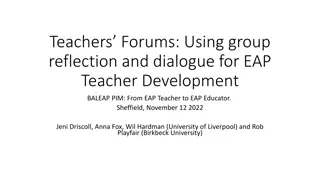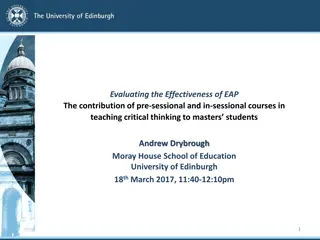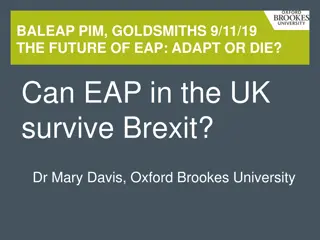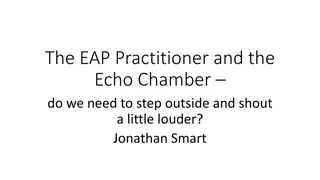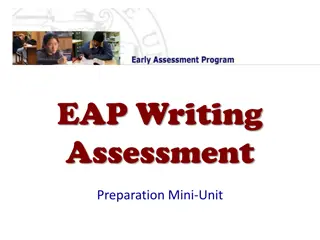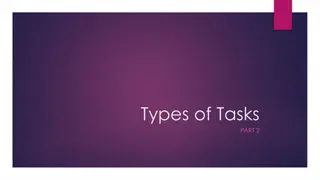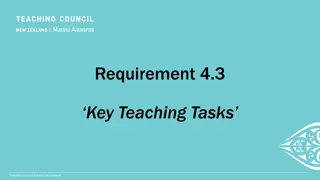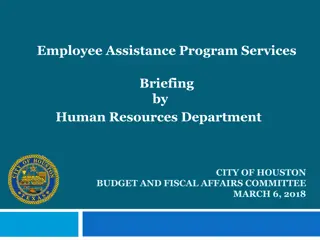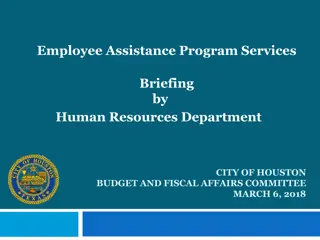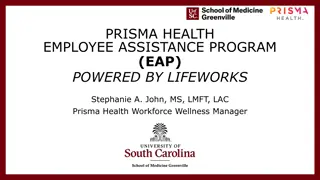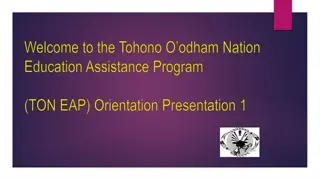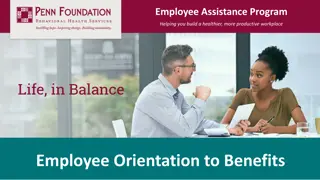Integrating Tasks and Actions in EAP: A Comprehensive Overview
Explore the integration of tasks and actions in English for Academic Purposes (EAP), including the evolution of professional language associations, frameworks for communication modes, skills essential for academic success, and strategies like Blooms Taxonomy for effective learning outcomes.
Download Presentation

Please find below an Image/Link to download the presentation.
The content on the website is provided AS IS for your information and personal use only. It may not be sold, licensed, or shared on other websites without obtaining consent from the author. Download presentation by click this link. If you encounter any issues during the download, it is possible that the publisher has removed the file from their server.
E N D
Presentation Transcript
Beyond the Text: Integrating Tasks and Actions in EAP Chris Smith University of Edinburgh Chris.R.Smith@ed.ac.uk
BALEAP Name Change? British Association Lecturers exclusive, change Professional? English for Academic Purposes Change to include academic literacies, but still retain English Language unnecessary, remove OK Professional Academic English Language & Literacy Association
Beyond the Text: Integrating Tasks and Actions in EAP Chris Smith University of Edinburgh Chris.R.Smith@ed.ac.uk
Overview Frameworks Reception Mediation Production Interaction
Frameworks Modes and Actions
The 4 skills The 4 skills Reading Writing Language Listening Speaking
The 4 Modes of the CEFR The 4 Modes of the CEFR the CEFR replaces the traditional model of the four skills which has increasingly proved inadequate to capture the complex reality of communication... Activities are presented under four modes of communication: reception, production, interaction and mediation (CoE, 2018, p. 30). Reception Production Language Interaction Mediation
The 4 skills in texts Reading Writing Listening Speaking Research Articles Essays Lectures Presentations
Blooms Taxonomy Level Taxon Actions / Outcome verbs 6 Create Produce, develop 5 Evaluate Appraise, critique 4 Analyse Relate, contrast 3 Apply Use, demonstrate 2 Understand Identify, describe 1 Remember Define, list
Learning Outcomes In this lesson I will explain how to cook a paella By the end of the lesson You will be able to Prepare ingredients Saut Simmer Serve In this lesson you will make a paella By the end of this lesson you will be able to make a paella
Reception: Reading and Listening
Text-oriented reading pedagogies Action-oriented reading pedagogies Skills approach Isolated Subskills Skimming & Scanning Actions Comprehension; language points Outputs Springboard for discussion Skills approach Integrated Subskills Summary, criticality, connections Actions ARCs, seminars Outputs Essays and presentations
Genre Analysis Actions Swales (1990) Very influential However, may still be text focussed Identify genre features (2) Compare genre features in different texts (4) How do we get learners to engage in the content of the text? Requires mediation
Academic Reading Circles ARCs 5 roles (Seburn, 2015) Leader Contextualiser Visualiser Connector Highlighter Why are they good? Student-centred Focus on content Employ high level actions
Roles with actions Role Actions Leader Develop discussion questions (6) Relate contributions (4) Compare, contrast & relate (4) Contextualiser Visualiser Relate (4), Design (6) Connector Evaluate & critique (5) Highlighter Identify & explain (2)
Some alternative roles Role Actions Highlighter Identify & explain (2) Visualiser (optional) Difficult for some Ss and texts Genre analyst Identify (2) and compare (4) Summariser Report (2) and organise (4)
Mediation introduces an additional element: the construction of new meaning, in the sense of new understanding, new knowledge, new concepts (Piccardo, North, and Goodier 2019, p. 21). Mediation
Integrated Reading Integrated Reading- -into into- -Writing Writing More than just Reading comprehension plus Written production
Paella Ingredients Finished Dish Rice Saffron Beer/wine Vegetables Meat/seafood Stock
Integrated Reading Integrated Reading- -into into- -Writing Writing More than just Reading comprehension plus Written production Summarising, paraphrasing, synthesising Analysis, critique, comment, comparison Mediation Reading Reading- -Mediated Writing Mediated Writing
Criteria Reading-Mediated Writing Criteria Reading Mediation Writing Understanding main ideas Understanding details Recognising stance Paraphrase and summary Comparison Criticality Grammar & Vocabulary Organisation Cohesion
Mediation Mediation Modes Tasks Reading-Mediated Writing Essay based on sources Summary of a text Reading-Mediated Speaking Presentation Academic Reading Circle Note-taking task Summary of a lecture Oral summary plus Q&A Discussion of a lecture Listening-Mediated Writing Listening-Mediated Speaking
Production Product and Process
Generative AI and Writing Tasks Monitor engagement with process: Plan Annotated Bibliography Evidence of reading Draft stages Tutorials Tutorial focus: 1. Have you found an article? 2. Have you read the article? 3. Can you link it to your essay topic?
Speaking Presentation Reading-mediated-speaking Seminars Group speaking Based on listening No spontaneity No interaction Same mediation as in writing tasks? More than just listening comprehension plus spoken production: Listening-mediated- interactional-speaking
Criteria Listening-Mediated Interactional Speaking Criteria Listening Mediation Interaction Speaking Turn-taking Topic management Body language Main ideas Details Fact & Opinion Summary Criticality Opinion Grammar Vocabulary Pronunciation
The actions of seminars By the end of the task cycle, you will be able to Identify of lectures (2) Use information from lectures (3) Compare your ideas with those of others (4) Argue and defend a position (5) Critique lecture content (5) Construct a position of knowledge (6)
Interaction Interaction is fundamental to language Essential part of the EAP construct
Signature Pedagogy Classroom practices: Both genre and process But above all action-oriented Knowledge Move away from prescriptivism Values Student-centred
A Framework for A Framework for Academic Language and Literacy Academic Language and Literacy Mode Reception Production Mediation Interaction Medium Written 1. Reading 3. Writing 5. of Reading 7. Written Spoken 2. Listening 4. Speaking 6. of Listening 8. Spoken
Asencin Delaney, Y. (2008). Investigating the reading-to-write construct. Journal of English for Academic Purposes, 7(3), 140 150. https://doi.org/10.1016/j.jeap.2008.04.001 Colina, S., & Lafford, B. A. (2017). Translation in Spanish language teaching: the integration of a fifth skill in the second language curriculum. Journal of Spanish Language Teaching, 4(2), 110 123. https://doi.org/10.1080/23247797.2017.1407127 Council of Europe. (2018). Common European Framework Of Reference For Languages: Learning, Teaching, Assessment Companion Volume With New Descriptors. Council of Europe Website. Retrieved from https://rm.coe.int/cefr-companion-volume-with-new- descriptors-2018/1680787989 Galaczi, E., & Taylor, L. (2018). Interactional Competence: Conceptualisations, Operationalisations, and Outstanding Questions. Language Assessment Quarterly, 15(3), 219 236. https://doi.org/10.1080/15434303.2018.1453816 Hinkel, E. (2010). Integrating the four skills: Current and historical perspectives. In R. B. Kaplan (Ed.), The Oxford Handbook of Applied Linguistics (2nd ed., pp. 110 126). Oxford: Oxford University Press. Piccardo, E., North, B., & Goodier, T. (2019). Broadening the scope of language education: mediation, plurilingualism, and collaborative learning: the cefr companion volume, 17 36. https://doi.org/10.20368/1971-8829/1612 Seedhouse, P., & Walsh, S. (2010). Learning a second language through classroom interaction. In Conceptualising learning in applied linguistics (pp. 127 146). London: Palgrave Macmillan. References References
Beyond the Text: Integrating Tasks and Actions in EAP Chris Smith University of Edinburgh Chris.R.Smith@ed.ac.uk
